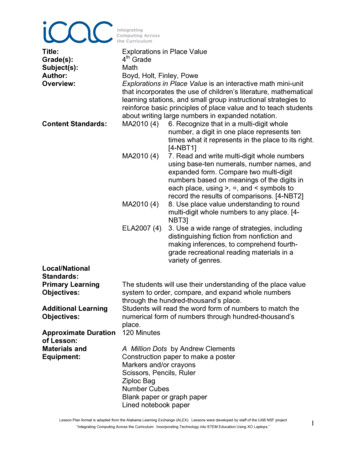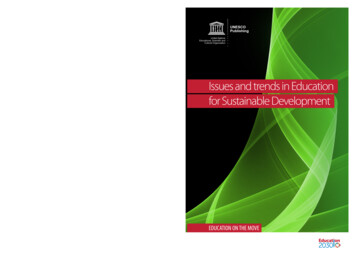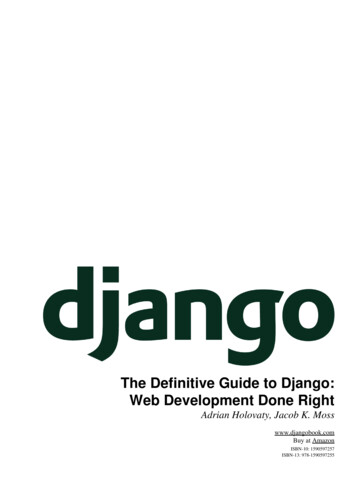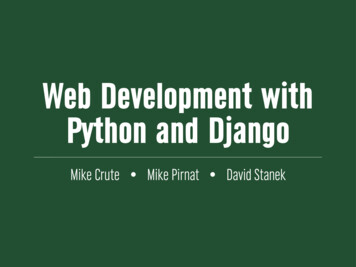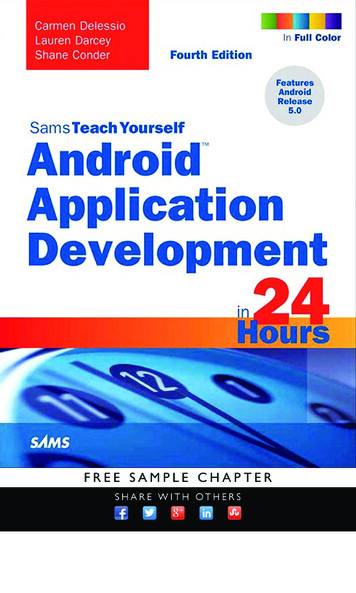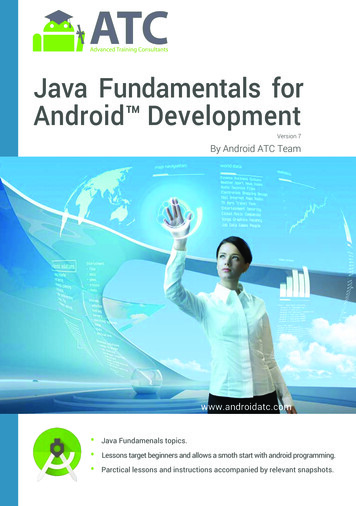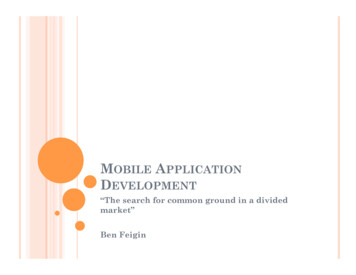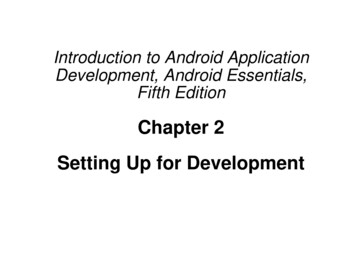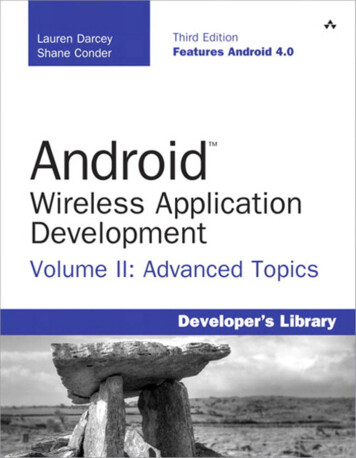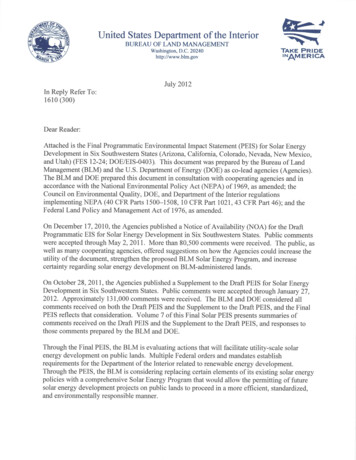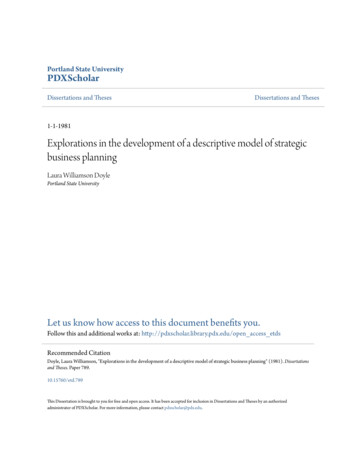
Transcription
Portland State UniversityPDXScholarDissertations and ThesesDissertations and Theses1-1-1981Explorations in the development of a descriptive model of strategicbusiness planningLaura Williamson DoylePortland State UniversityLet us know how access to this document benefits you.Follow this and additional works at: http://pdxscholar.library.pdx.edu/open access etdsRecommended CitationDoyle, Laura Williamson, "Explorations in the development of a descriptive model of strategic business planning" (1981). Dissertationsand Theses. Paper 789.10.15760/etd.789This Dissertation is brought to you for free and open access. It has been accepted for inclusion in Dissertations and Theses by an authorizedadministrator of PDXScholar. For more information, please contact pdxscholar@pdx.edu.
EXPLORATIONS IN THE DEVELOPMENT OF A DESCRIPTIVE MODEL OFSTRATEGIC BUSINESS PLANNINGbyLaura Williamson DoyleA dissertation submi.tted in partial fulfillment of therequirements for the degree ofDOCTOR OF PHILOSOPHYinSYSTEMS SCIENCEPortland State University(91981 Laura Williamson Doyle
TO THE OFFICI: OF GRADUATE STUDIES AriD nI:SBAHC1::The mel:lbers of the COL1i1itteeLaura \!illiarason Dorle presented pprcv(;Febru r ·tl'.c c!issertation of23, 19C1 Ci.airr.,;anQuentin D. Clarl:sou'APPROVED:StanleJ' Rauc l., Dean of Graduate Stu ies anc Rese rcl'
AN ABSTRACT OF THE DISSERTATION of Laura \o1illiamsol1 Doyle for theDoctor of Philosophy in Systems Science presented February 23, 1981.Title:Explorations in the Development of a Descriptive Hodel ofStrategic Business PlanningAPPROVED BY HEHBERS OF THE DISSERTATIOH COH11ITTEE:ew S\iN.Gosl n,Cnal.rrcanQuentin D. Clarl :sol1The intent of this exploratory case study \'las:1)tocompareamodel of expected forual business plan contentwith the content of actual businessplansdeveloped within asinglecompany,2) todevelopamodifiedmodel of formal business plan contentwhich recognizes organizational influences on plan content,3) to propose. a method for evaluating business plans. based on thismodified model.
2firmT estudiedwasFastDeltamultidivisional manufacturing company in aTheCorporation, a "Fortune 500"hightechnologybusiness plan content analyzed in this study wasplanning system similar to those implementedbyindustry.through ap oduaedother multidivisionaloompanies.In this study,planningbymanagement was the primary focus.analysis of formalplanmiddle managerswas basedThe study methodcontentratherthan topratheronthedirect observation orthaninquiry about the planning process.Study steps included:1)testof goodness of fitbetvleen a simple model of expectedbusiness plan content and the actual content of business plansproducedthrough the Fast Delta Corporation planning system.2)analysis of deviations of the actual content froe the expectedcontent model.contentwithThis analysis included comparison of actual formalplannon-content characteristics of the formal plans, with thecontent of business strategy case studies from other firws, and with thethe content ofFastDeltaCorporation managers'responsestocasestudies in business strategy.Theresultsofthisstudyshowedformal business plan content was influencedincludedshort-term corporate-wideb rseveral factors.ofthestudyfirm;andon strategy which may be characteristic of other fi!'Ins \-lithsimilar structure, at a similar life cycle stage,industry.Theseconcerns; shared assumptions amonGmanagers about the strengths and limitationsconstraintsthat Fast Delta Corporationor withinthesame
3Fromtheseresults a modified model of business plan content '-jasdeveloped which considered these influences.suggests that the plan gtheThe validity of this modelusedinthisstudywereplanning assumptions whichunderlie business plan content produced through a firm's formal businessplanning system.Theresults and conclusions of this study are significant for topImanageuent, middle management, corporate planning staff, and those doingresearch in strategic planning.
ACKNOWLEDGEMENTSIwish to thank Drs.Bellerby, Clarkson, Goslin, and Moseley fortheir suggestions on the design and presentation tion.Sabal for the ideasthey've presented through the Systems Science Program which Itodrawon in the preparation of this dissertation.Tom Long and CalSmith of Fast Delta Corporation deserve my gratitude for theirin this project.Finally, my deepest appreciation owas ableinterestmy husband for hispatience, support, and encouragement in this long-term project.
TABLE OF CONTENTSPAGEACKNo\-JLEDGEHENTS LIST OF TABLES LIST OF FIGURES viii iii xCHAPTERIINTRODUCTION·'.Background, Purpose and Significance of this Study 11BackgroundPurposeSignificanceOvervieu of the Hodel of Expected Plan Content 4Description of the Expected Content HodelObjections to the Expected Content HodelIntent of this StudyIIDescription of the Study Firm12Description of Business Planning at TheCorporation16Limitations of this Study20Summary23REVIEH OF THE LITERATUREExpected Content of Formal Business PlansCorporate Strategy and Strategic BusinessPlan ContentNormative Hodels of Strategic Business PlanContentImplications of Basic Content Hodel forPlanning Process2525
vCHAPTERPAGEObjections to the Expected Content Hodel29Expected Content Hodel SimplicityProcess Hodel ValidityHodel UtilityIIITechniques for Studying ASSUI.:ption Sets38 Ul1lnary3940STUDY 11ETHOD40Overviei-l of HethodObjections to the Expected Content liodel basec.ion its Si&plicityObjections to the Expected Content Hoclel baseci.on Operating ContextObjections to the Lxpected Content Hodel based.on Organizational CO(lte tHodel Comparison: Expected Content Hodel vs ActualStrategic Plan Content45Variable SelectionVariable CodingData TabulationData AnalysisCorporate Consistency:Business PlansContent SiLlilarity anone49Rationale for Sit,ilarity CoefficientCalculationSimilarity Coeffficient CalculationFactor Analysis:StrategyIdentifyingCOLlple; COf:lponents of52Non-Content Descriptors of Corporate Plans 53Planning Exercise:LOGic55Planning Process vs PlanninGPlanning Exercise ParticipantsQuestionnaire Developr.lcnt: Part A and Part 13AdministerinG QUestionnairas
viPAGECHAPTERGodin:::; Quostionnaire TICGIJOll:SCSAnalycis of Questionnaire ResultsRelative Corporate Consistency: Cow?arison of For alPlan Content vs Business Case Study Content59Case Study SelectionDifferences Between Case Studies and ForealPlansSinilarity Coefficient CalculationPlanninG Exercise: Planninc LO;iic and !lc.nasers'Professional CharacteristicsIVRESULTS 65Goodness of FitTest:Plan Content} xpectedCorporate Consistency:Corporate PlansStrategic Factors:VBActuc:l65Sil.ilarity Coefficients for 8Factor Analysis of Plan Contentlion-Content Descriptors:Plan ContentPlanning Exercise:LOGicContent l-iodelPlan Characteristic:::' andPlannin,; Proces.s and Planain.:.;717579Relative Corporate Consistency: SiL:ilarity aLlon.:.;Business Case Studies vs Si,;.ilc::.rity ar,loac Forl.;o:.lPlans82PlanninG Exercise:Characteristics87I·lanaGers' Professiol'lalPlanninG LOGicVBContent Variables and Hanager t CharacteristicsSimilarity Among HanagersSULlI.1aryV SUin JARY, conCLUSIONS AHD RECOi·jHE!JDATIOlJSSummaryPattern of StrategiC LoSicRole of Current Activities959797
viiPAGECHAPTEROrganizational Icpacts on PlanContentConclusions 101COrlparison of Actual \Olith Expected Plan ContentDevelopDent of a Hodified Hodel of Plan ContentSuppleLlental Evaluation Hethods for StrateGicPlansRe cOLlllend at ions 110Top ria.na(;eoentl idclle Hana er,lentCorporate Planning StaffFor Further StudyREFEREI CESCITED117APPEHDIX A123APPElJDIX B125APPEI:DIX C128D140APPEIIDIX E146APPEl.;nI
LIST OF TABLESPAGETABLEISummary of Key Variables which Characterize the7Expected Content Hodel54IISummary of Non-Content Variables Describing PlansIIIVariables Used to Describe Professional Experience63of Questionnaire RespondentsIVSummary of Content Variable Pairs with SignificantJoint FrequenciesV66Comparison of Similarity Coefficients under Agreementand Disagreement for Condition and ActionVariables for Formal PlansVI69 Summary of Relative Agreement-Disagreement ScoreDifferencesVIIVIII70Results of Factor Analysis of Plan Content72Content Variables Significantly Associated with PlanYearIX76Content Variables Significantly Associated with Past77Performance and Performance ForecastsXComparison of Part A Results with Basic Hodel and withFormal Plan ResultsXI Comparison of Part B Results with Basic Hodel and with 80
ixTABLEPAGE80Forjjlal Plan ResultsXIICouparison of Similarity Coefi'icients under AgreeIJentand DisaE:;reenent for CondJ.tion Variables between83ForLlal Plans anti Case StudieGXIIIConparison of Siuilarity Coefficients under AgrceQcntand Disagreeoent for Condition Variablesbetl1E en84ForLlal Plans and Case StuuiesXIVSUlli,lary of Rala ti voA reeL1ent-Disazreer.1(mtScore85DifferencesXVSummary of Content Vi:1riables SiGnificantly Related Hitil88Lencth of ServiceXVISUJ::l:lary of Content Variables Sibni:i:'icantly Helateci. \,'ith90Functional ExperienceXVIISUl:illilary ot Contant Variables SiGnificantly Relatedl-ianat.;ellent LevelXVIII·,·:l.t:l91Hesul ts of Sir. ilari ty Coefficient Calculation:: forSub-Grou sof !;anacers93
LIST OF FIGURESPAG:::;FIGURE1.SUIllrJary of Business Research as the Expecteci Conter,t Hodel.2.Couparison of Fast Delta Corporation Hulti-divisionalStructure \-lith General Hulti-divisional Structure3.Overvie\-i of Strategic PlanninG Process Illustratil1t,;Three Key Features4.1518Overviet·; of Fast Delta Corporation StrateGic PlannincProcess5.'.619Overvieu of Strate;;ic Planning Process fornl onentuL:.21Plans"6.Hodel of UorIlative Planning Process337.Hodel of Hodified Planning Process338.Flow Chart SUWiJarizing Study l·'ethod9.COIilparison of Factor Analysis Results with the Basic 73Hodel froId Figure 110.Hodified Hodel of ForLlal Business Plan Content 11.Hatrix of Alternative Approaches to StrateGic LogicTraininG Program41 03106
CHAPTER IINTRODUCTIonTopicscoveredin this chapter include:significance of this studyp overview of a Dodelbackground, purpose andofexpectedstrategicplan content, description of the study firm, description of the businessplanning process at the study fire, and limitations of this study.BACICGROUHD,PURPOSE Arm SIGHIFICAIJCE OF THIS eyears,bothglossary,process and content models ofAppendixA,p. 123)havebeendeveloped which assume that organizations and their plans and activitiescanbeevaluatedin terms of efficiency or rationality.These modelsare reviewed in the first section of Chapter II (p. 24).Thesemodelshavebeenlv-idely adoptee. and iLlpleuented in larl3ecorapley. business organizations despitewhichthey are based.thesimplisticassuoptionsonHanagers have learned to rely on these models intheir attempts at rational achievement and control and siraplification oftheir increasingly complex environments.1978,62)(Business HeekDeceuber18,At the same time, other models of organization activities bemoredescriptive of actual behavior under the arabiguous values and incomplete
2knowledgewhich characterize strategic business planning.have not been used explicitly inplanningsystems.thedesignandThese modelsanalysisof(Sarrazin 1978) The second section of Chapter II (p.27), discusses three major objections to the simple strategymOdelsandformalevaluationseveral- alternative perspectives on strategy settinG whictare based on organizational behavior models.PurposeThe objectives of this exploratory study were threefold:1)tocompareamodel of expected plan content with the actualbusiness plan content developed in the study firw,2)todevelopamodifiedmodelofformal plan content \;11ichrecoGnizes organizational influences on plan content,3)to propose a oethod for evaluating business plan content basedon this modified model which can be used at The FastDeltaCorporationand other siuilar cOtlpanies.The preliminary step in this exploratory study was a couparison ofthe content of the business plans produced through theatsyste Fastcontent model.CorporationDeltaCorporationThe sinilarity of theformalplanninG(The Corporation) with an expectedplanningsystematFastDeltato those implemented by other multidivisional decentralizedcorporations is discussed in thefollollingsectionsofthischapter(P. 4).SignificanceThechiefreason for attempting such a model building effort wasthe potential for improving the effectiveness ofcurrentdecentralized
3strategicplanningsystems.Developingamoreaccurate or completemodel of business plan content would:1)provideadditionalinsights uhich can aid middle manaGers inthe development of business strategy and top managers in the developmentof corporate strategic ganization's characteristics anduhothedesiGnimpactandofaon its formal planli itscontent.3)facilitateformal plans.ev&luatingtheevaluationofinfornation'Ihis is important for both staff andplansandfortop management inruakin conveyed throushtopmanage!Jentindecisions based onplans.This model building exercise is unique in several uays:1) The primary focus of this study is the content of busine!Js unitplansdevelopedthroughthe forual decentralized planning systen of asingle large mul tina tional,products manufacturer.a)thatthemul tidi vision,higi1-technolos rindustrialThis focus is based on tuo considere:.tiol1s:planninGprocess and plannil1G logic can be deducedfror;:l the analysis of plan content; and,b)thatin a decentralized "bottom-up" planning syster.l corporatestrategy appears not as a single top manage!Jent business plan, but asaportfolio of business investment opportunities described by the plans ofbusiness units.Thisapproachisdifferentstrategic business planning in that:fromIi10stdescriptivestudies of
4a)moststudiesare bas
strategic planning systems. Developing a more accurate or complete model of business plan content would: 1) provide additional insights uhich can aid middle manaGers in the development of business strategy and top managers in the development of corporate strategic direction.
